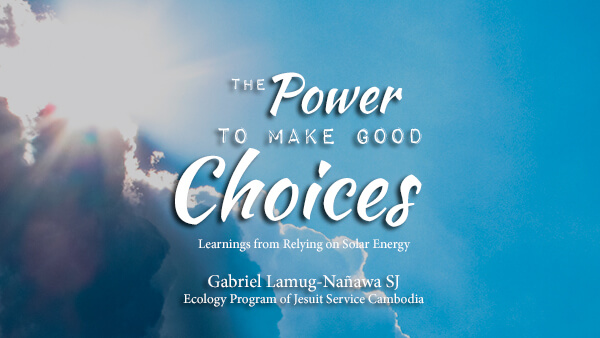


Gabriel Lamug-Nañawa, SJ
Two years ago this March, we installed in our office of the Ecology Program of Jesuit Service Cambodia in Phnom Penh, a solar power system to provide for the electrical requirements of the entire office. With only 3 laptops, 1 printer, 3 fans, a couple of lights for working at night, and the periodic charging of phones and other devices, it isn’t a very big office. Nevertheless, we decided to disconnect the electrical lines of our office from the main building in which we were located and to try, from then on, to be fully dependent on the sun’s radiation.

Solar panels are being installed on the roof of the office of the Ecology Program of Jesuit Service Cambodia.
After two years of relying on the sun for our electricity needs, we would like to report that it has been a very positive experience for us. Here are some lessons we learned along the way.
First, we grew more conscious of the energy situation of the country and the main sources of the electricity that we use. We learned that the capital city of Phnom Penh consumes around 90% of the total electricity of Cambodia, leaving 10% to be shared by the rest of the country. This distribution is certainly skewed given that approximately 80% of the total population of 16 million live in the rural areas.
The main sources of energy in Cambodia have always been derived from fossil fuels. Up until 2011, 90% of the electricity was produced by diesel generators, an inefficient process which deposits the greenhouse gases of carbon dioxide and nitrous oxide into the atmosphere. As the economic development of recent years meant greater energy demands, hydropower and coal became part of the energy source mix. Thus, in 2015, diesel generators provided only 5% of Cambodia’s total electricity consumption, the main sources now being hydroelectric dams (43%) and coal (51%). The increased use of coal, however, meant even greater CO2 emissions than when diesel generators were used.
Furthermore, since Cambodia also depends highly on imported fuels, the resulting electricity price, at around 0.21 US$/kWh in Phnom Penh, is one of the highest in the region and even in the world. By comparison, the cost of electricity is 0.10 US$/kWh in the US, 0.15 US$/kWh in the UK, and 0.19 US$/kWh in Germany.
Knowing where our energy comes from and how it is produced makes us all more informed and empowered to respond more appropriately to the situation.
The second lesson we learned was discovering which appliances in the office consumed less energy and which ones consumed more. For example, we realized that laptops generally use much less energy than desktops. A 14 to 15-inch laptop typically requires 60 watts when being used and 20 watts when idle, compared to the average desktop which needs 200 to 300 watts while in use and 60 watts while idle. This means that laptops need around 80% less electricity than desktop computers do.
Regarding light fixtures, the most efficient and durable choice these days are LED (light-emitting diode) bulbs. For instance, given the same lumens (i.e., the total quantity of light emitted by a source) of 800 lm, an incandescent lamp would need 60 watts and will last for 750 hours, a CFL (compact fluorescent lamp) 14 watts for 10,000 hours, and an LED 12 watts for 50,000+ hours. Thus, LEDs last the longest while consuming the least amount of energy. Also, CFLs are quite dangerous as its tubes contain toxic mercury vapor which is re-leased when the lamps break.
In addition, we also decided to give up our hot and cold water dispenser, which alone required 550 watts to run. Although this meant no more easy access to cold drinks and hot tea at the office, we were quite happy to make this small sacrifice so that we could keep on using solar power and reduce the carbon that we dump onto the earth.
Becoming more aware about the different energy demands of the devices and appliances we all use, means that we can better control the total amount of energy that we use. We cannot manage what we cannot measure.
The third lesson of relying on solar power and not being connected to the national grid, aside from not contributing more greenhouse gases, was that we felt we were able to make a new step towards having right relations with creation. Our work of forest restoration and environmental education, or in essence, our work for creation was being powered by creation itself. This cycle made us feel more integrated with all other beings, embraced and included into the intricate web of dependencies that all beings share with one another. The source of energy for our activities was benign, and it felt satisfying not to be contributing to climate change and to more harm upon the earth.
We also believed that there was prophetic value in our reliance on the sun, and that somehow it shed light on other possibilities. In fact, fairly recently, we were happy to hear that the whole Banteay Prieb, the Jesuit vocational school in Cambodia for people with a disability, decided to shift to solar energy as well.
We understand that solar energy may not be everyone’s choice. But there are countless other ways that we as individuals and institutions can do to care for creation. St Ignatius’ magis beckons us that there is always a better option before us, a choice that is more respectful and more loving, that can carry us towards greater harmony and reconciliation with all our neighbors, human and otherwise. This is a power that is ours, given by God. May it not go to waste.
________________
Care of the environment and reconciliation with creation are integral components of the Jesuit mission. Fr. Gabriel Lamug-Nañawa, SJ or Fr. Gabby is currently missioned to Cambodia and coordinates the Ecology Program of Jesuit Service-Cambodia. Be our mission partner by visiting the JesuitAid website.